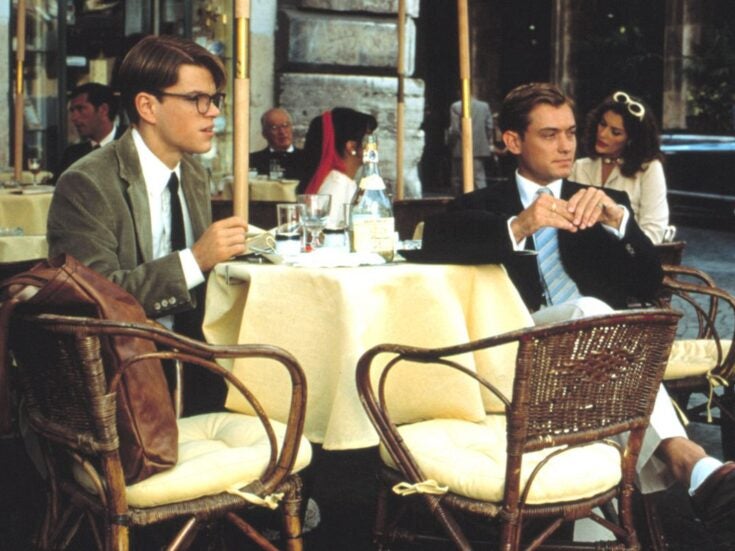Tantalising tidbits from London’s spikiest columnist: Art at 45 Park Lane, Liechtenstein on the rack, Eric Lanlard’s afternoon tea
The Art of the Hotel
They came in at irregular intervals, but once they had all arrived and sat at the long table and set to their task, there was an oddly quiet intensity of concentration in the room. One man signed the book and passed it to his neighbour, who signed it and passed it to his, before picking up the next copy and signing and passing it over. A glass of white wine was brought in for Bill Wyman. Three Bloody Marys stood untouched at the end of the table.
This production line was inking copies of Art at 45 Park Lane, and the signatories were the artists featured, who have each created and provided work for the new Dorchester Collection hotel on Park Lane. Nor does this group assembled by hospitality guru Roy Ackerman consist of any painters-by-number, but some of our best and most reverend artists: Sir Peter Blake, there with two of his children; Joe Tilson, another major Pop artist; Brendan Neiland, Martin Fuller, Patrick Hughes, William Packer, young Christian Furr, the polytechnic Bill Wyman. There are some Hirst butterfly constellations in Cut, but I’m not sure anyone was surprised — or disappointed — by his absence.

Rotten Row by Peter Blake, on display at 45 Park Lane
The artists were signing for their supper, having to finish the task before we could go down for lunch in Cut. Sign they did, and it was surreal, like watching all the Best Actor Oscar nominees performing in the same scene. The presence of one great artist at a time you can take in, but so many at once, each with that blasé halo that surrounds icons and heroes, meant a sort of mental buffering, a constant questioning of whether you were really seeing it.
Hedgehog was. After we tramped downstairs, Roy did the placement and I ended up at the argumentative but good-natured end of the table. Two artists quarrelled about whether the Royal Academy should have thrown out mandatory life drawing classes from their educational programme, one approving the shift towards conceptual, digital, video, free-form art, the other regretting that today’s artists did not have their predecessors’ drafting skills. A third artist, of the younger generation, felt that the RA had to move with the times. Over a delicious fillet steak, I took it all in. For dessert — a retro-modern Black Forest bread pudding — I had moved places next to Wyman, who told stories of archaeology and ghosts.
There was plenty of bemoaning of the revived — necromanced? — Dover Street Arts Club. Many of these gentlemen (for it is all boys in 45 Park Lane’s collection) complained about the soulless hedgies who haunt it, the loss of any actual connection to the arts world. I complained about the £14.50 you pay for the worst eggs Benedict in London. Despite being life members, they fear being edged off the rolls to make way for those who can pay. Much better to stick to the Chelsea Arts Club, less chic but a lot more welcoming.
Of course, thanks to Roy Ackerman’s clever deal, they can always spend time at Cut: as well as being paid for their work and being invited to this, their monthly gathering, each artist has credit for meals there. Having seen the price of the steaks, though, they might have to sell a few more paintings if they want to invite a guest.
45parklane.com

Masterclass

It seems as if half of London society — by which we mean global society — traipsed past the Spear’s booth at the Masterpiece London art fair, in the grounds of the Royal Hospital Chelsea, over its eight days.
The broad range of stands had something for the Russian oligarch in everyone’s life: antiquities from the Merrin and Cahn galleries, Modern paintings from Dickinson (which was right on the money with a massive Miró), fine furniture from Mallett and Old Masters from Philip Mould. (Read what Philip Mould had to say about what makes a masterpiece at the Spear’s breakfast debate on page 27.)
This spread also included luxury brands such as Rolls-Royce, Theo Fennell and Vacheron Constantin, which did not meet everyone’s approval — some feel it detracts from the fair’s overall seriousness. One gallerist said that Masterpiece ‘is aimed more at lifestyle than heavyweight art and antiques’ and wasn’t quite the rival to Maastricht it thought it was.
This is unfair: what Masterpiece is aimed at is helping collectors to pick the best of the best, whether that means a van Dyck sketch or a new diamond pendant. Dickinson, for example, put out blue-chip artists: as well as the Miró, who has broken his sale record twice this year already, there was a bruisey van Dongen, a silvery Warhol and a late Picasso, the era of whose oeuvre has better supply.
Who it was aimed at is a different question. The Russians of Chelski were clearly one target, hence the one-stop-shop approach. (The more discriminating Evgeny Lebedev came through on Wednesday.) Judging by the numerous Chinese works on display, Asian millionaires, who were present in splendid and gratuitous force, were also on the menu.
Jonathan Coulborn of Thomas Coulborn & Sons had a series of twelve Chinese gouaches depicting the process of making ceramics, made for European eyes and previously owned by prime minister Lord Grenville. Going for £12,500 (as was another similar set depicting the tea ritual), the pictures had appeal, said Coulborn, because the Chinese are now looking beyond Imperial work, which is expensive and scarce, to work produced about China or by the Chinese for export. Canton/Guangdong province in particular was a fertile source of clients for this, he said.
Carol Woolton brought some of her sparkle to the fair with Brilliant, an exhibition with more diamonds than the back of Liz Taylor’s sofa. All the big names had contributed a piece, some new for the show: Stephen Webster studded diamonds into a swatch of leather tattooed with a dragon; Chris Levine revisited his popular holograph of the Queen by adding a tiara of Asprey diamonds; De Beers provided the most expensive piece (POA, natch), a two-pound white-gold talisman set with 271 carats of rough diamonds, the fruit of ten years’ acquisition of perfect stones (see left).
When Masterpiece announced that Gagosian would be creating a project, they couldn’t have imagined that meant dusting off a silver Marsyas sculpture by Hirst and sticking it in front of Le Caprice. It was so terribly lazy and even dismissive.
Rather more than dismissive was the Gagosian harridan who tried to stop Hedgehog tweeting a photo of the offending item. When we pointed out to her that this was on display in public, she gave us a sickly smile and dropped her injunction. Gagosian, she said, likes to control which images appear, as if we hadn’t yet guessed.
Gagosian gag aside, Masterpiece resumed its position as the fair of the finest objects.

Fair Treatment?

After the prime minister of Liechtenstein and a senior British HMRC official signed a new tax treaty between the two countries in June, they celebrated with smiles and jokes what felt like compulsion and redemption.
The tax treaty and the Liechtenstein Disclosure Facility, said Jürgen Frick, CEO of Liechtenstein’s Bank Frick, made the country compliant with dirty-money regulations, but what had to be done was change Liechtenstein’s image in the public mind: ‘We have adapted. We have got to get people to realise we are no longer a tax haven.’
The UK-Liechtenstein Double Taxation Treaty prevents income taxable in both states from being taxed in both states, but more importantly it contains a provision for the exchange of information between the countries: if Britain thinks one of its taxpayers is hiding money in Liechtenstein, it can demand details.
The DTT follows the creation of the Liechtenstein Disclosure Facility, which allows Britons to bring hidden money onshore through Liechtenstein and only pay a proportion of the tax they would otherwise have owed plus a small penalty. So far, 2,400 people have taken up this offer, and one lawyer at the press conference after the signing said he had just moved £70 million into Liechtenstein, with a £12 million tax bill.
Prime minister Klaus Tschütscher told Spear’s that Liechtenstein had had to haul itself up from a very low point in 2008. ‘From the bottom with the Zumwinkel affair,’ Tschütscher said, ‘we’ve negotiated 30 treaties from the green ground.’
In 2008, a damaging scandal broke about wealthy Germans, including Klaus Zumwinkel, CEO of Deutsche Post, hiding money in Liechtenstein, and secret client data from Liechtenstein’s banks were sold to the German government. In 2009, Liechtenstein was included on the OECD’s blacklist of uncooperative tax havens published after the G20 meeting in London.
After the scandal, Liechtenstein began to repair its reputation by signing DTTs. It is working out treaties with Austria, Germany, Italy, the US and France, although the prime minister said that France was proving difficult — ‘they have to find their own position’ since François Hollande’s election. Sarkozy had been no easier: ‘After every G20 conference he would go out and start talking about Switzerland and Liechtenstein with no background knowledge.’
The signing of the innovative LDF in 2011 was another step forward, and provided relief for both Liechtenstein — which was now Britain’s eager partner in combating tax evasion — and Britain, because it could stop leaning on Liechtenstein quite as hard and stood to reap billions from the deal.
Dave Hartnett, the permanent secretary for tax at HMRC, told Spear’s that the government had been hoping for £1 billion from the LDF but had so far made £3 billion. When asked whether there would be more money from similar disclosure facilities with other countries, he said with a jollity not immediately attributable to a taxman, ‘I’ll have to tease you: we’re talking to four other countries. We won’t do the LDF again — that was our commitment to Liechtenstein.’
These measures didn’t mean an end to banking secrecy, said Fritz Kaiser, a senior banker in Liechtenstein and one of the instigators of the LDF and the country’s repairing of its reputation. Lazy journalists assumed it did, ‘but secrecy isn’t dead — secrecy is still important, but not to misuse it’ by evading tax.
So everyone seemed happy at the Institute for Civil Engineers in Westminster: HMRC got tax and information from Liechtenstein; Liechtenstein got Britain off its back; and lawyers had more work processing the LDF disclosures. Won’t someone spare a thought for the poor tax evader?

Self-Service

With purse strings tightening all over the city, entertaining at home is a cheaper option but there is no reason why it should be any less elegant. The front-of-house team at Alain Ducasse at the Dorchester are running the Art of Fine Dining masterclass to show you — or rather, show your staff who can show you — just how to get a three-Michelin-starred dining room in your very own home.
Led by Nicolas Defremont, the charming restaurant director, the classes walk participants through the basics of entertaining, from tablecloths and cutlery to the finer points of making the most of everyone’s favourite dinner party guest, the wine. For less than the price of a meal out in the restaurant you can send the butler off to learn how to create wonderful dinner parties over and over again. That is just good home economics.
Learning in the spacious, pristine surroundings of the restaurant is rather lovely, especially watching the actual front-of-house team go about their work in the far corners of the room, folding napkins, pressing tablecloths and redoing the dreadful attempts at laying tables over which attendees of the course spent so long agonising earlier. This should prove inspirational to your staff and also ticks the box of providing continuing professional development, which is all the rage in the modern workplace.
During the two-hour class every aspect of mise en place is covered and helpful feedback on the straightness of cutlery will be given. Once the tricks of the table are learnt, participants’ attention is drawn to our old friend, the wine. Vincent Pastorello, sommelier at Alain Ducasse, leads the class in a 30-minute wine-tasting session at the end of the masterclass.
Here they have crockery designed by Hermès worth over £200,000, but even if yours is merely Thomas Goode there are ways to get the very best out of your homeware and create a wonderful table to complement your caterers’ very best cooking attempts. With in-house staff trained by the best in the business you can sit back and watch as Fay Maschler gives you five stars. So what should you notice changing in your dining room?
Alain Ducasse’s top tips:
Crisp linen: Insist on a double iron, once away from the table and one in situ to ensure a professional finish. Ironing should be done from the centre outwards.
Sparkling crockery: A little vinegar in the spritzer along with a clean cloth and a strong arm will ensure all watermarks or other unsightly marks are removed from your porcelain.
Depth perception: When putting your table together, best to keep it simple, hence elegant. You should expect plates, cutlery, glasses and napkins (preferably carefully folded into linen artichokes as taught by the Ducasse team) to be approximately a finger’s width apart.
Small details: For thoughtful extra touches, buy in — or have the caterer make — a few different types of bread and provide both salted and unsalted butter for your guests.
The Art of Fine Dining masterclass costs £120 per person and includes a signed
Alain Ducasse cookery book. Call the reservations department at Alain Ducasse at the Dorchester on 020 7629 8866
Emily Rookwood
Tarty

Afternoon teas are springing up all over London’s grand hotels and top restaurants, with plenty of innovative items: Nobu’s octopus dumplings, anyone? Still, there’s quite a lot to be said for a more traditional approach, which is what Eric Lanlard has done at the Jumeirah Carlton Tower. This somewhat understates his achievement: he has blown the dust — literally and metaphorically — off their tea service and given it a shock of colour and a subtle palate.
It follows the savoury-sweet-scone formula, but the elements are judiciously refreshed. Prawn and lobster royale in brioche, cream cheese and cucumber wheels and ornate smoked salmon sandwiches sit on the top deck of the narrow Deco-ish cake-stand. The brioche satisfyingly straddles the boundary between kitsch and fresh, and besides, it’s so tangily delicious it doesn’t matter.
The second tier is the most inventive. Eton mess in a shotglass with a tiny pipette of mango coulis appealed, as did the tiny tarts with a white chocolate portrait of the Queen, as if Warhol did patisserie. The red velvet cake ball in white (but green) chocolate with a dark chocolate crown was too sweet for Hedgehog’s taste, suggesting refined sugar in a sugar crust, but it’s a lovely idea.
Finally, you hit the scones. As a baker of scones, Hedgehog can happily confess that these are superior, and they’re simple — no yuzu curd or goat’s milk cream.
Eric is the new baker-boy on the block, with his own TV show (Baking Mad on Channel 4) and a new book out, Tart It Up!, so capturing him is quite a coup for the Jumeirah. Rather than other places where afternoon tea seems a desperate add-on, here is a year’s worth of work which actually feels rather subtler than the Jumeirah’s usual vibe.
Among the rash of afternoon teas, if you’re around Knightsbridge, you should profitably check out Eric Lanlard’s: enough wit to keep your attention, more than enough flavour to keep you eating.
Afternoon Tea by Eric Lanlard at the Jumeirah Carlton Tower costs £40 per person, plus service, or £45 with a glass of champagne. Book at jumeirah.com
Read more from Hedgehog
Don’t miss out on the best of Spear’s articles – sign up to the Spear’s weekly newsletter
[related_companies]





